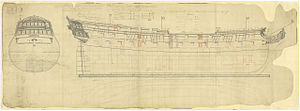|
HMS Defiance (1783)
HMS Defiance was a 74-gun third rate ship of the line of the Royal Navy, built by Randall and Co., at Rotherhithe on the River Thames, and launched on 10 December 1783.[1] HistoryShe was commissioned by Lt M.T. Hewitt for Captain George Keppel. He sailed her with the Channel Fleet during September and October 1796 at which time it was reported that,
Her crew mutinied three times, firstly in October 1795, when she was under the command of Captain Sir George Home. He initially had to release the ringleaders when the ratings attempted to storm the officer's quarters, but later these and additional mutineers were put in irons when,
The stationing of the Army troops was required because the ship sailed without its contingent of 60 Marines, which later embarked at Sheerness. On 23 March 1796 Captain Theophilus Jones took command. The crew of the Defiance mutinied for a second time in 1797 during the Spithead mutiny. Captain William Bligh of the Calcutta was ordered to embark 200 troops and take them alongside in order for the troops to board Defiance and regain control, however the threat of the soldiers was sufficient to bring about an end to the mutiny. Her ship's company mutinied again in 1798 during the rising of the United Irishmen.[4] Eleven men were hanged and ten transported for life in the penal colony of New South Wales. Her next Captain was Thomas Revell Shivers, who took command on 27 February 1797 at Torbay. In 1798, some of her crew were court-martialed for mutiny.[5] In the summer of 1800, Defiance was attached to the squadron under Sir Alan Gardner, stationed off the Black Rocks. On 24 December 1800, Capt. Richard Retallick superseded Capt. Shivers, Defiance being selected for the flagship of Rear Admiral Sir Thomas Graves.  She fought at the Battle of Copenhagen on 2 April 1801, as the flagship of Rear Admiral Thomas Graves, with Captain Retallick commanding. The station in the line occupied in the battle was abreast of the Crown battery, which mounted thirty-six heavy guns, and was provided with a furnace for heating shot. Owing to the mishaps that kept Bellona, Russell, and Agamemnon from taking up their assigned stations, the Defiance became exposed to a severe cross fire, from which she suffered very severe damage.[6]
Finnisterre and TrafalgarShe also participated in the Battle of Cape Finisterre on 22 July 1805, and the Battle of Trafalgar on 21 October, whilst under the command of Captain Philip Charles Durham, who claimed that "she was the fastest 74 gun ship in the British fleet".[citation needed] At Trafalgar the Defiance captured the Spanish San Juan Nepomuceno,[citation needed] and the French Aigle (although the following day the French crew managed to recapture the Aigle from the British prize crew shortly before she was wrecked during the storm of 23 October).[7][8] Prior to the boarding of the Aigle by a full boarding party from the Defiance, James "Jack" Spratt dived into the sea from Defiance, swimming with a cutlass between his teeth to the Aigle he climbed in through a stern window and boarded her single handed. He found his way to the French poop deck and threw himself on the French crew, one man against several hundred. In the melee he killed two French seamen, and was grappling with a third when he fell from the poop deck to the main deck, killing his opponent but injuring himself badly. He was saved by the timely arrival of a full boarding party from Defiance.[9] During the battle of Trafalgar Defiance and sustained casualties of 57 killed,[10] and 153 wounded.[citation needed] Final service and fateIn 1809, she took part in the Battle of Les Sables-d'Olonne. Lloyd's List reported in February 1809 that the man-of-war Defiance had sent the French cutter Prudente into Plymouth. Prudente had been on her way from Guadaloupe.[11] FateAfter serving as a prison ship at Chatham from 1813, she was broken up in 1817.[1] Captains
Trafalgar Wood ProjectAs a part of the Trafalgar Wood Project to commemorate the 33 Royal Navy ships that were at Trafalgar, a wood of 10 acres (40,000 m2) was planted in October/November 2005 in Dumfries, Dumfries and Galloway, Scotland to honour HMS Defiance.[citation needed] Citations and notes
References
Further reading
External links
|
||||||||||||||||||||||||||||||||||||||
